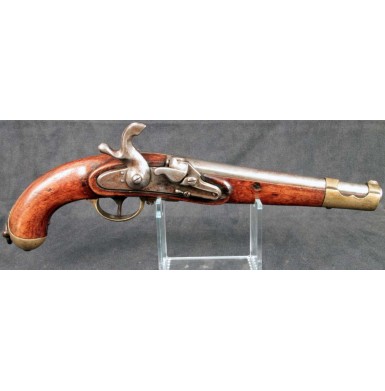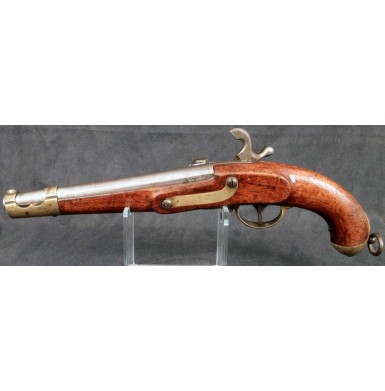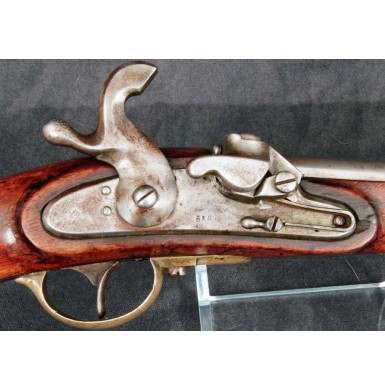Austrian Kavalleriepistole M-1851 Mit Tragring
- Product Code: FHG-1375-SOLD
- Availability: Out Of Stock
-
$1.00
This is a scarce example of the Austrian Kavalleriepistole M-1851 Mit Tragring or rather Model 1851 Cavalry Pistol with Carrying Ring. These single shot, muzzle loading “horse pistols’ were among the last of the of the heavy dragoon style pistols to be used by the Austrian cavalry. The pistols were 16.9mm (about .665 caliber) and used the Augustin Consol Lock (aka “Tube Lock”) ignition system. As was the practice with many of the elite Austrian military units who used specialty weapons, the M-1851 pistol was not equipped with a ramrod channel, and the rammer was carried separately on the belt of the cavalryman. The guns were 423mm (16.65”) in overall length with a 251mm (9.88”) barrel and weighed a very manageable, yet sturdy 1550g (1.212 lbs). The pistol was produced in two variations, one with a sling ring on the rear of the club butt, and one without. In typical Austrian fashion the locks were marked with the Austrian Eagle to the rear of the lock plate and the year of production (omitting the first digit) forward of the hammer. The names of private makers (contractors) were often present on the top of the barrel, near the breech. The pistols were stocked in the traditional Austrian beech with brass furniture that included a butt cap and double-strapped barrel band. In Continental fashion, the muzzle of the pistol, the barrel band and the stock were all finished flush together at the muzzle. This style of single shot pistol design was common in Austria and many other German speaking countries in the 19th Century. The Austrians adopted the percussion system (“System Lorenz”) in 1854 and the majority of the M-1851 pistols still in service were altered to percussion ignition at that time. By the end of the 1850’s, the Austrians had replaced the smoothbore M-1851 with a rifled percussion pistol based upon the Lorenz rifle musket, and bearing a striking resemblance to that arm.The Austrian Kavalleriepistole M-1851 Mit Tragring offered here is in about VERY GOOD+ to NEAR FINE condition. The best part about the pistol is that it retains its complete and fully functional Augustin Console “tube” or “pill” lock ignition system. The system used an encapsulated copper primer with two hollow wire leads that extended from either side of the central casing. These leads formed a flash channel that communicated the ignition charge directly to the powder charge. One lead was inserted into the flash channel of the pan and the other stuck out of the opposite side of the pan. Closing the pan cover crimped off the lead on the non-ignition side, making sure that all of the priming force entered the main flash channel to ignite the primer charge. Once the pan was closed, a firing pin in the top of the pan rested upon the priming “pill” and the fall of the hammer forced the firing pin into the “pill”, igniting it. The expended priming tube was easy to remove from the pan, as the offside lead could be used to grab it and pull it out of the pan. The large majority of the M-1851 Pistols on hand in Austria were altered to percussion between 1854 and 1860. This pistol is 100% complete and correct in every way, and retains sharp markings that are quite clear. The lock is clearly marked with the (AUSTRIAN EAGLE) at the tail of the lockplate, and with the date of manufacture, 854 forward of the hammer. Additional Austrian proof marks and the date 856 are present on the left side of the barrel near the breech, just above the level of the stock. The top of the barrel is marked with the name of the manufacturer: Florian Schütz , presumably a gunmaker in Wien (Vienna). The top of the breech is additionally marked with a single capital G and the tang is marked 54. The brass barrel band is struck with an upside down F in a depressed circle, which is probably the mark of Kaiser Ferdinand I, who ruled Austria during this time. The pistol lock and Augustin Consol system work perfectly and the gun is in mechanically excellent condition. The iron lockplate has a medium dark gray patina, with some scattered darker brown age staining and some light peppering and pinpricking. The barrel has the same general appearance, with more of a dove gray color and scattered darker age staining and minor discoloration. There is some light to moderate peppering and pinprick pitting in the breech area “ not uncommon with pill lock or percussion lock guns due to the highly caustic nature of the priming compounds used during the era. There is also a thin, scattered layer of brownish oxidation starting to develop along portions of the barrel, lock plate and hammer. This could easily be cleaned off if so desired. The .66 caliber smooth bore is dark and dirty with light to moderate scattered pitting along its entire length. The brass furniture (triggerguard, butt cap, side plate and barrel band) has a lovely, untouched deep mustard patina. The original iron “carrying ring” is in place on the butt of the pistol and its patina matches the other iron parts of the pistol well. The Beachwood stock is in NEAR FINE condition overall and is very attractive. The wood has the usual, slightly orange tone to it, which is often seen on Austrian arms. The stock is complete and solid with no repairs. There is a minor grain crack on the right side of the stock, running diagonally form the front of the lock mortise up to the barrel channel. This crack is likely the result of the forward lock screw being over tightened. The crack is about 2 ““ in length and appears to follow the grain. It seems stable and in no way affects the appearance or display of the pistol. The only other flaw is a tiny sliver of wood missing from the very top edge of the stock, between the two straps of the brass barrel band on the left side of the gun. The missing sliver is less than ““ in length and in no way effects the display. It is mentioned only for correctness. Other than these two minor items, the stock is solid and without any other flaws “ only the usual bumps and dings from service that one would expect to see on a mid-19th century cavalry pistol.
Overall this is a really a very attractive example of one of the last major continental single-shot cavalry pistols. It is difficult to believe that this pistol was in use during the same time frame as the Prussian “Needle Rifle” was coming into use. These large bore, single shot muzzle loaders really defined the end of an era of heavy cavalry and dragoons. Finding one of these unique pistols is difficult enough, but finding one with the original Augustin ignition system makes this gun a true rarity. For the collector of 19th Century Austrian weapons, this is a must have pistol. For a Civil War era collector, it is a rare opportunity to own an original Augustin ignition firearm. Some surplus Austrian long arms were actually delivered to US forces in the early days of the Civil War with their original pill lock systems, so this pistol makes a unique footnote to the story of the many continental weapons that found their way to America’s shores during the Civil War.
SOLD




